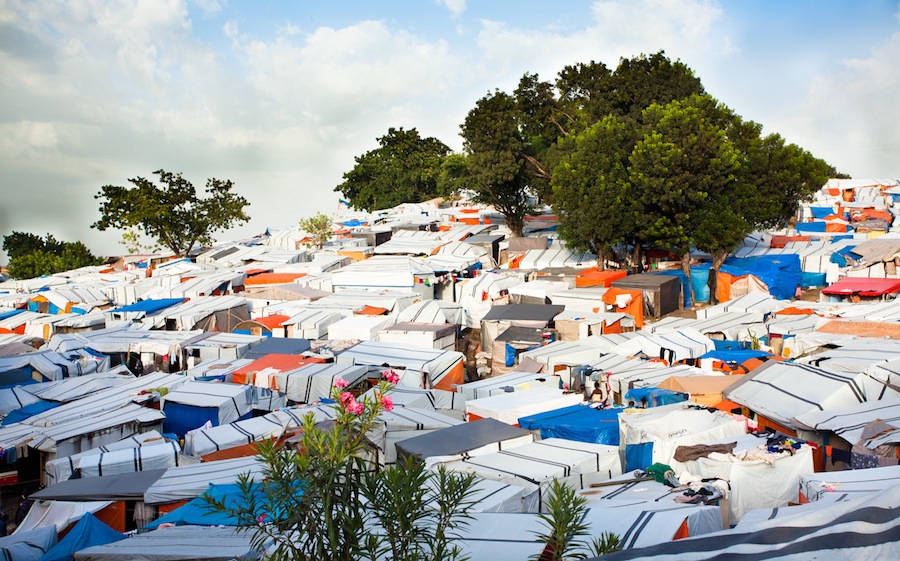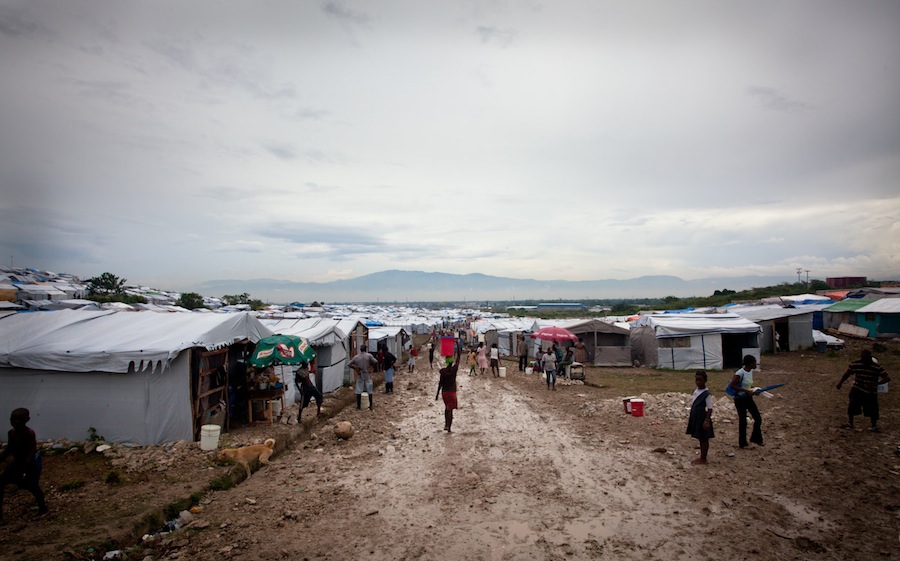Tent Life
Photographs of the aftermath of the 2010 earthquake in Haiti, where Wyatt Gallery found an unexpected and unlikely sense of hope in tent cities.

Interview by Nicole Pasulka
I interviewed you in 2007 about portraits you’d done in post-Katrina New Orleans. What have you been up to between now and then?
The honest truth is that I wasn’t up to much. With the recession, I ended up moving out of the U.S. and shooting a lot of advertising campaigns in the Caribbean and doing a lot of work for the New York Times as their Caribbean photographer. Continue reading ↓
All images used with permission, © copyright the artist, all rights reserved.








Interview continued
And how did you end up actually traveling to Haiti?
I’d lived in the Caribbean for the past few years, and because of my past experience shooting natural disasters I felt I had to contribute. When the earthquake hit, I talked to a couple friends of mine and said I really want to go to Haiti—we should go together and shoot together. But I couldn’t get anything to happen.
Then another friend had an advertising agency and that guy grew up with a friend whose uncle has Healing Haiti, a small NGO in Haiti that deals with orphans and delivers water. We said, “Let’s go and volunteer with Healing Haiti.” At the time, none of us had any money. There wasn’t any work. We couldn’t afford to pay for everything ourselves the way we did with Katrina and the tsunami. So we asked the BBDO Agency, the advertising agency the guy is the head designer for, and they gave us $5,000 to go to Haiti to volunteer. We went down with Kareem Black, Alessandro Simonetti, Craig Duffney, filmmaker Eugene Fuller, writer Adam Reeves, and Print for Change director Jeremy Carroll for a week in March.
What kind of volunteering did you do?
We would deliver water. We had this huge water tank truck and we basically stood on the sides of the truck and hung on for dear life. We drove through the worst neighborhoods in Port-au-Prince and people said, “Don’t go there.” But we went and people were super receptive and happy. We took photographs of people while filling up their water buckets. We helped old ladies carry their water buckets home. It was great to be of service.
We also went to orphanages and we taught art to children there. Because this guy Craig Duffy was a designer, he loves using colorful putty-clay. He brought all that down and he taught them how to make animals and objects. The next thing you know they’re making microphones and cell phones, and they start talking to each other on the phones, then they start singing on the steps. All the sudden we’ve got 20 kids having like a Haitian Idol TV show. We start filming it and I have a whole other set of photos of these children. We’re going to release that separately—we call it the “Hey You, Haiti” project.
Had you gone in a volunteer capacity with other projects or was this the first time your trip had a dual purpose?
This was the first time I’d done that. I think there was much more of an intimacy and closeness with the subject matter and the people. I wasn’t just traveling with myself, I was with a translator and with Healing Haiti, people who’d been in Haiti for years. They knew we could go to these neighborhoods and nothing was going to happen. If I’d just gone by myself, and people had said, “You can’t go there,” I wouldn’t have gone.
I came to Haiti with a lot of love, and one of my purposes was to give love to the people in Haiti. One of the things we realized right away is the children were starved for love. Imagine losing your home and the parents are just trying to survive every day. Sometimes taking children’s photographs is just about making them feel great and giving them a smile. We realized that a smile is a precious commodity in Haiti right now.
What was your overall experience with NGOs there?
When I went in September for the second time, I didn’t officially volunteer with anyone, but I spent all of the time in different refugee camps. I became really close with Sean Penn’s camp, J/P Haitian Relief Organization. I ended up kind of helping out in the hospital when they got crowded. People would say, “Hold this IV.”
As much as people want to say, “The aid hasn’t reached Haiti, no one’s doing anything,” that’s not true. The camps where there are NGOs managing the camp and working with them, there’s a much better quality of life than in the camps where there’s no NGO. J/P Haitian Relief Organization have an art center, they have different schools, they have a gutter system, they have a whole market area. They have security guards at night to make sure people aren’t getting raped. It’s the best someone could have in this tragic situation right now.
A lot of people who travel in turbulent areas as professional photographers struggle with some standard of objectivity, or believe they have to be a detached observer. As a photographer did you worry about being too involved?
I interact a lot with people as I’m shooting. I’ll end up hanging out with them, talking with them. We had duffle bags full of Clif Bars, we’d give them out to anyone we saw. We had Vitamin C candies. We weren’t removed at all. I’m not there to be on the outside. I think these photographs are about an outsider being on the inside. Literally, being in someone’s tent with them, being close to them. I don’t have a zoom lens. You don’t see it, but often times there are like four children jumping on top of me while I’m shooting someone else because they’re just excited to be with me.
If you’re shooting for a magazine, then maybe you have to stay neutral and get your job done. But I don’t have a job. I’m shooting for myself. I don’t have to get any images for anyone. I’m just doing what comes naturally to me. For me, the Caribbean is my second home. Being around Caribbean people is the norm for me. If this were Trinidad, where I’ve lived for many years, my ass would be on a plane right away to do whatever I can for my friends.
It’s clear from the photos that the situation there is desperate, but the images are surprisingly hopeful. Did you intentionally try to show a side of the disaster less grim than usual?
It was not my plan in going there to have this outlook. This is what I saw in Haiti. I wanted to show how bad it is, the destruction, and make people feel so sad, but it just didn’t happen. I have a poet friend who was looking at the photographs and said, “These just aren’t sad. They give me hope and inspires me to believe that because they still have hope, we can have hope.”
What should people in the U.S. or elsewhere who are distressed about conditions in Haiti know? What can they do?
Remain positive. Their contributions do make a difference to someone in Haiti. I highly trust and believe in J/P Haitian Relief Organization. If there’s anyone out there who wants to give money, but doesn’t trust that it’s gonna do anything, I give my word that J/P Haitian Relief Organization is going to do everything they can with that dollar. Buy my book—the money’s going to a good cause. Right now it’s pre-orders before it comes out in bookstores in April. Or go to Haiti and volunteer. Whatever you can do.
